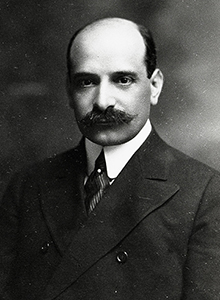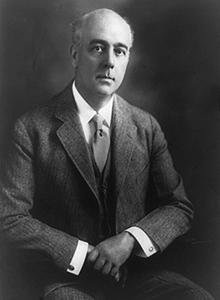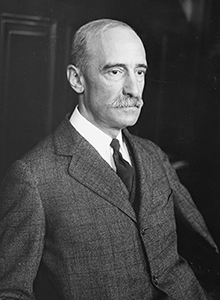
Paul M. Warburg
- Vice Governor, Federal Reserve Board, 1916 – 1918
- Member, Federal Reserve Board, 1914 – 1916
- Born: August 10, 1868
- Died: January 24, 1932
Paul M. Warburg was sworn in as a member of the first Federal Reserve Board on August 10, 1914. He was appointed vice governor on August 10, 1916.1 He resigned from the Board on August 9, 1918.
Warburg was born in Hamburg, Germany, in 1868. He graduated from high school in Hamburg in 1886 and began working for an exporting firm there. He then moved on to positions at shipping and banking companies in London and Paris. He returned to Hamburg in 1895 and became a partner in the banking firm M.M. Warburg and Company, founded by his great-grandfather.
Warburg was a partner in the family firm until 1907. However, in 1902, he moved to New York City and joined his father-in-law's company as a partner overseeing international loans to several governments. In 1911, he became a naturalized US citizen.
Warburg was considered one of the top authorities on central banking both in Europe and the United States and was active in the monetary reform movement taking place in the United States in the early 1900s. He gave speeches, published several articles advocating the establishment of a US central bank, and was an unofficial advisor to the National Monetary Commission, which was established following the Panic of 1907 to study banking system reform. In 1910, Warburg was one of six men, including Sen. Nelson Aldrich, to participate in a secret meeting on Jekyll Island, Georgia, that resulted in a plan for a National Reserve Association. Although the "Aldrich plan" was rejected by Congress, it laid the foundation for the 1913 Federal Reserve Act, which created the Federal Reserve System. President Woodrow Wilson appointed Warburg to the new entity's first Board in 1914.
Although Warburg left the Federal Reserve Board in 1918, he continued to serve the Federal Reserve as a member of the Federal Advisory Council (1921-26). He resumed his activities in business and philanthropic circles as well. For example, he founded and was the first chairman of the Executive Committee of the American Acceptance Council in 1919. In 1921, he organized the International Acceptance Bank to promote US government financing of reconstruction in Europe following the war.
Warburg was also a director of the Council on Foreign Relations (1921-32), a trustee of the Institute of Economics (1922-27), and a trustee of the Brookings Institution after it merged with the Institute of Economics in 1927. He also helped establish the Carl Schurz Memorial Foundation in 1930. He served at various times as a director of the Baltimore and Ohio Railroad, Union Pacific Railroad, and Western Union Telegraph Company. Warburg was also a director of the Julliard School of Music and a trustee of Tuskegee College.
Warburg continued to take an active interest in the nation's monetary affairs and banking system. In March 1929, he warned that the wild stock speculation resulting from stock price increases and improper bank lending practices would have disastrous results if left unchecked. On October 29 of that year, the stock market crashed.
Throughout his career, Warburg was a prolific writer. Most notable among his published works was a two-volume set on the Federal Reserve System published in 1930. The Yale University Library (Manuscripts and Archives) is the repository for Warburg's papers dating from 1904 to 1932. The collection includes 169 volumes on banking and finance.
Warburg died at his home in New York in 1932. At the time of his death, he was chairman of the Manhattan Company and a director of the Bank of Manhattan Trust Company, Farmers Loan and Trust Company of New York, and First National Bank of Boston.
Endnotes
- 1 Governor was the title of the active executive officer of the Federal Reserve Board from 1913 to 1935. The Vice Governor worked with the Governor to conduct the Board’s business and led the Board in the Governor’s absence. See the Board of Governors website and the essay on the Banking Act of 1935 for details on changes in the Board’s leadership structure over time.
Written by the Board of Governors of the Federal Reserve System and updated on October 14, 2025 by Federal Reserve History staff to clarify the historic titles used before 1935. See disclaimer and update policy.



 X
X  facebook
facebook
 email
email